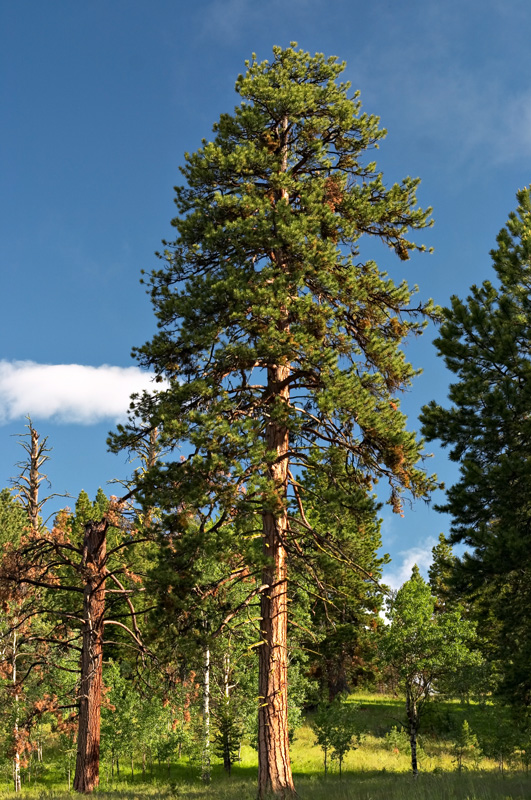Pinus Ponderosa
 Definer of the "Great Timber" region of the West, this long-needled, majestic tree can grow to 230'. Its cones are favorite Christmas decorations. Will grow anywhere in the U.S. with full sun and well-drained soil.
Definer of the "Great Timber" region of the West, this long-needled, majestic tree can grow to 230'. Its cones are favorite Christmas decorations. Will grow anywhere in the U.S. with full sun and well-drained soil.
Also know as the Blackjack or Western Yellow Pine, this evergreen was first reported by members of the Lewis and Clark expedition in 1804. Twenty-two years later it was named by the famous Scottish Botanist, David Douglas, for its heavy or "ponderous" wood. The Ponderosa was mistaken for two different trees due to the differences between the younger and older of its kind.
For the first 80-100 years, the bark of the Ponderosa is smooth and a dark brown-black, leading to the name Blackjack Pine. Later, the bark of the older tree is an orange-brown color with deep ridges. Its growth area is often known as the "Great Timber" region because of its tall majestic stance. It is the most common pine in North America and is widely distributed. This distribution leads to different varieties or subspecies of the Ponderosa.
 The seeds in this kit are Western variety, though it is capable of growing in 90% of the country. Depending on its environment, the Ponderosa grows from 60 to 230' high with a diameter of 21/2 to 8'. Its needles grow 2 or 3 to a bundle and are 4-8" long- stout, stiff, and dark green. Its cones are conical or egg-shaped and 3-6" long, very woody and a favorite Christmas decoration. Birds and other wildlife consume the seeds. Ponderosa is the primary commercial tree species of this country, used to make 2x4’s and plywood products.
The seeds in this kit are Western variety, though it is capable of growing in 90% of the country. Depending on its environment, the Ponderosa grows from 60 to 230' high with a diameter of 21/2 to 8'. Its needles grow 2 or 3 to a bundle and are 4-8" long- stout, stiff, and dark green. Its cones are conical or egg-shaped and 3-6" long, very woody and a favorite Christmas decoration. Birds and other wildlife consume the seeds. Ponderosa is the primary commercial tree species of this country, used to make 2x4’s and plywood products.
The Ponderosa is a fine, attractive tree at any age and makes a good bonsai. Natural Habitat of the Ponderosa: The western variety is found mostly in the mountains at elevations of 4000-12,000 feet. It has moderate resistance to drought, high cold resistance, likes slightly acidic and well drain soil. Intolerant of shade. Good for ornamental, timber, windbreaks and reforestation.
